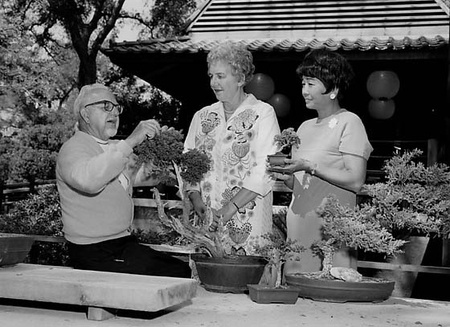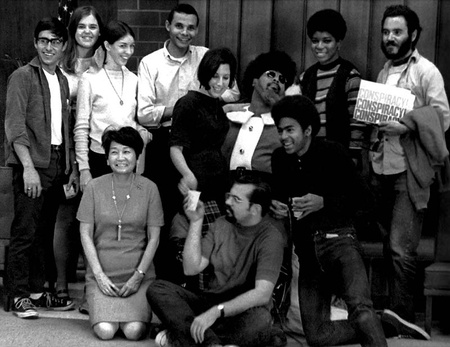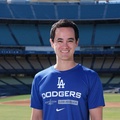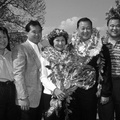My mother passed away last October at the age of 92 and there are so many things about her that I will never know. Mom had a tumultuous early life, but as the youngest of her four children, I was privy to few of her darkest moments. When she and my father would make references to camp when I was a boy, I thought they meant a summer camp and not a concentration camp. So much of what I do know about Kiyoko Kay Moritani Komai is information from others, like my aunts and uncles, my older siblings, and her friends. There was a period of time when Mom would not want to speak about the past.

Khan and Kay Komai. My parents were pioneers in the development of interest in bonsai throughout California and around the world.
I remember returning home from college one weekend, excited and angry because of a sociology class that laid out a clear view of the unconstitutional forced removal and mass incarceration of Japanese Americans during World War II by the U.S. government. This was a subject that I knew almost nothing about. I wanted to write a paper on the experiences of my family being illegally held in a concentration camp in Amache, Colorado. I directly asked Mom about life in camp. “Oh, you don’t want to know about that,” she said and then left the room.
In looking back, I should not have been surprised by my mother’s reaction. In my career at the Japanese American National Museum, I found that most Japanese Americans who lived through the war were reluctant for decades to talk about that unhappy chapter of their lives. Japanese cultural values, such as shikata ganai (roughly, “it can’t be helped”) and gaman (“enduring the unbearable with dignity”), which enabled the Nikkei community to survive overwhelming adversity and rebuild their lives, created a prevailing attitude among Japanese Americans to “not cry over spilled milk.”
Things changed in the 1970s and 1980s when the Japanese American redress movement gained momentum. One of the greatest benefits of the redress campaign, beyond the eventual official government apology and reparations, was the necessity for former inmates to describe their experiences in public. Reliving the horrors of being treated like criminals or worse by their own government was emotionally wrenching, but I believe it was the best therapy for our community. Twenty years after asking my mother about camp, I witnessed her speaking on camera as part of a BBC documentary on Japanese Americans and saying with much emotion that entering camp in Colorado was “the saddest day of my life.” She even got one of my uncles to speak on camera about his experiences.
It is remarkable to me as a Sansei that our parents and grandparents were so resilient in the face of such events. But my mother was even more amazing when you have this perspective: before she turned 22, she had already lost a younger brother in infancy; had been sent from Berkeley to Los Angeles to live with her uncle and aunt when she was 6; lost both her parents to tuberculosis; was told by her high school guidance counselor that she could never become a teacher since she was Japanese; was pregnant with her first child when the Japanese bombed Pearl Harbor in 1941; and was forced to bring her newborn baby to live in the Santa Anita Racetrack and then in the Amache concentration camp. Personally, before I reached the age of 22, I was worried about having enough credits to graduate college and whether my skin would ever clear up.
Certainly, from my point of view, if Mom had spent the rest of her life raising her four children and supporting our father, that would have been a full life. But, Kay Komai always wanted to do more. Mom was smart and even skipped a couple of grades in school. She learned shorthand, the abbreviated writing system prevalent before dictation machines, and she was so proficient, her teacher recommended that she apply for a job at the Department of Motor Vehicles. Mom was offered the senior stenographer position, even though she was not yet 16, the minimum age for the job. She had a full social life, joining the Japanese American Blue Circle girls’ club. She remembered seeing Khan Komai in her neighborhood and decided he was the smartest person she knew. She would marry him less than a week after she turned 20, because she had promised her late father she would not marry until she was no longer a teenager.
Life in the horse stables of Santa Anita and then the dusty barracks of Amache with a newborn baby was traumatic for my mother. In the 1990s, she told me about all the dust, the lack of privacy, the horrible toilet set-up when they first moved to camp, and even an infestation of locusts. She begged my father to get the family out of camp, which finally happened in 1944 when Daddy took a job in a battery factory in Ohio, where my sister was born. Returning to Los Angeles after the war, my family crowded into my grandfather’s old house with my father’s siblings and their families.
In the late 1950s, Mom spent most of her waking hours devoted to her job at California State University, Los Angeles and bonsai. Her uncle, Frank Nagata, who adopted her (the Nagatas were our surrogate grandparents), was one of the founders of the California Bonsai Society in the 1950s. He mentored our father in the Japanese cultural art of cultivating miniature trees, but it was my mother who pushed our Dad to become a bonsai instructor. After years of driving Grandpa to speaking engagements and acting as his translator, Daddy had expressed his growing interest in bonsai. Mom bought two trees and two pots for Daddy’s birthday and said, “Let’s see what you can do.”

Mom worked with several bonsai organizations in places like Descanso Garden to promote the Japanese cultural art. Photograph by Toyo Miyatake Studio, Gift of the Alan Miyatake Family, Japanese American National Museum. (96.267.1031)
When our family moved from the Seinan area, where the Santa Monica Freeway was being built, to Temple City, my father opened the Komai Bonsai Nursery. His goal was to teach bonsai, but given the limited audience (almost all bonsai instruction was in Japanese at that time), he had to sell steer manure and take landscaping jobs to keep the business afloat. Mom worked with our father to advance bonsai and our parents were instrumental in the establishment over the next three decades of a number of key organizations, including the Santa Anita Bonsai Society, the Satsuki Azalea Bonsai Society, and the Golden State Bonsai Federation. If Grandpa and Daddy were among the prime instructors, Mom saw her role as the promoter of both to attract a greater audience to bonsai.
Remarkably, Mom was doing all her bonsai work in her spare time, since she also developed her own career. Denied her opportunity to become a teacher, she was hired to do clerical work for a new university known at the time as L.A. State College in 1958. Later, she was promoted to Secretary to the Associated Student Body President and reported directly to the University President. Mom spent countless hours on campus at Cal State L.A., developing lifelong relationships with the students. Some like Los Angeles County Supervisor Michael Antonovich and former Los Angeles County District Attorney Steve Cooley went on to prominent careers, but Mom always stayed in touch with all of “her boys.” She was also the sponsor for the Japanese American sorority, Kappa Zeta Phi, and the Alpha Phi Omega service fraternity. Ultimately, Mom was promoted to the managerial position for the University Student Union until her retirement in 1983 after 25 years.

Mom was involved with various student groups in her 25 years at California State University, Los Angeles.
With her free time, Mom was able to travel with Daddy on trips abroad for bonsai, visiting Japan, Australia, and South Africa. Even after our father passed away in 1996, Mom stayed involved with bonsai, especially with the annual “Winter Silhouettes” show at the Los Angeles County Arboretum, a show she helped to create that gathered together many of Grandpa’s former students. She also communicated regularly with Jim Folsom, Director of the Botanical Gardens at the Huntington Library in San Marino, to help to develop the institution’s bonsai collection.
Interestingly, Mom was also pretty well informed when it came to health issues. When our father was diagnosed with diabetes, she really watched his diet and took care of him. Recently, while going through her house after she passed, I noticed a couple of bookshelves filled with medical information books. I always thought Mom did not read books that much, but she would if she was motivated. In her later years, she had hip replacement surgery and an operation on her heart, which was remarkable since she was in her 80s at the time. Many doctors are reluctant to conduct such a serious operation on someone that old, but Mom convinced them that she was healthy enough to handle the stress. She also did the research on assisted-living facilities and chose one in Arcadia, which, not accidentally, was centrally located geographically amidst my two brothers and sister. Mom also continued to get together with the remaining Blue Circle group and still traveled to bonsai conventions around California.

Mom (2nd from right) joined the Japanese American girls' club, the Blue Circle, before World War II, and continued to meet well into her 80s. (from left) Masako Miyake, Aki Yamazaki, Florence Goto, Tokiko Matsumoto, Kay Komai, Emiko Kuromiya
When Mom turned 90, I told her that I thought she could live to 100, since her overall health seemed stable and her mental faculties were still pretty good (although her hearing was terrible). But, in the next couple of years, fluid began building up near her lungs and her memory became unreliable. My siblings and I took turns taking her to the doctor, but not much could be done to treat her at her advanced age. She passed away peacefully under hospice care in October, an ending that most of us would choose if we could.
As I said, there are so many things I will never know about my mother. But, I know what is most important about her: that she was strong in the face of adversity, smart when opportunities presented themselves, and loving and loyal to her family and friends. I didn’t just learn this from others. I learned it from how Mom lived her life.
© 2014 Chris Komai





